Email remains a cornerstone of successful marketing and lead-generation strategies for businesses of all sizes. Recent statistics by HubSpot show that 77% of marketers have seen an increase in email engagement over the last 12 months. One of the significant reasons for email success in the recent past is executing sales email sequences tactfully. Well crafted sequences enable companies to reach potential customers, nurture leads, and drive conversions through personalized, targeted communication.
Sales email sequencing offers a cost-effective and scalable way to engage with prospects, build relationships, and guide them through the sales funnel. When executed correctly, it can yield high returns on investment and contribute significantly to revenue growth and business success.
By identifying and understanding these common pitfalls, businesses can proactively avoid making costly mistakes and optimize their email campaigns for better engagement, response rates, and, ultimately, sales success.
This article will help you know the pitfalls to avoid when crafting sales email sequences. While email can be a powerful tool for driving conversions, it can fall flat or worse hurt your reputation if not executed thoughtfully.
Through practical insights and examples, this article aims to equip go to market teams with the knowledge and strategies needed to navigate the complexities of sales email sequences effectively, ultimately enhancing the overall effectiveness of their sales efforts.
5 Things You Must Avoid In a Sales Email Sequence
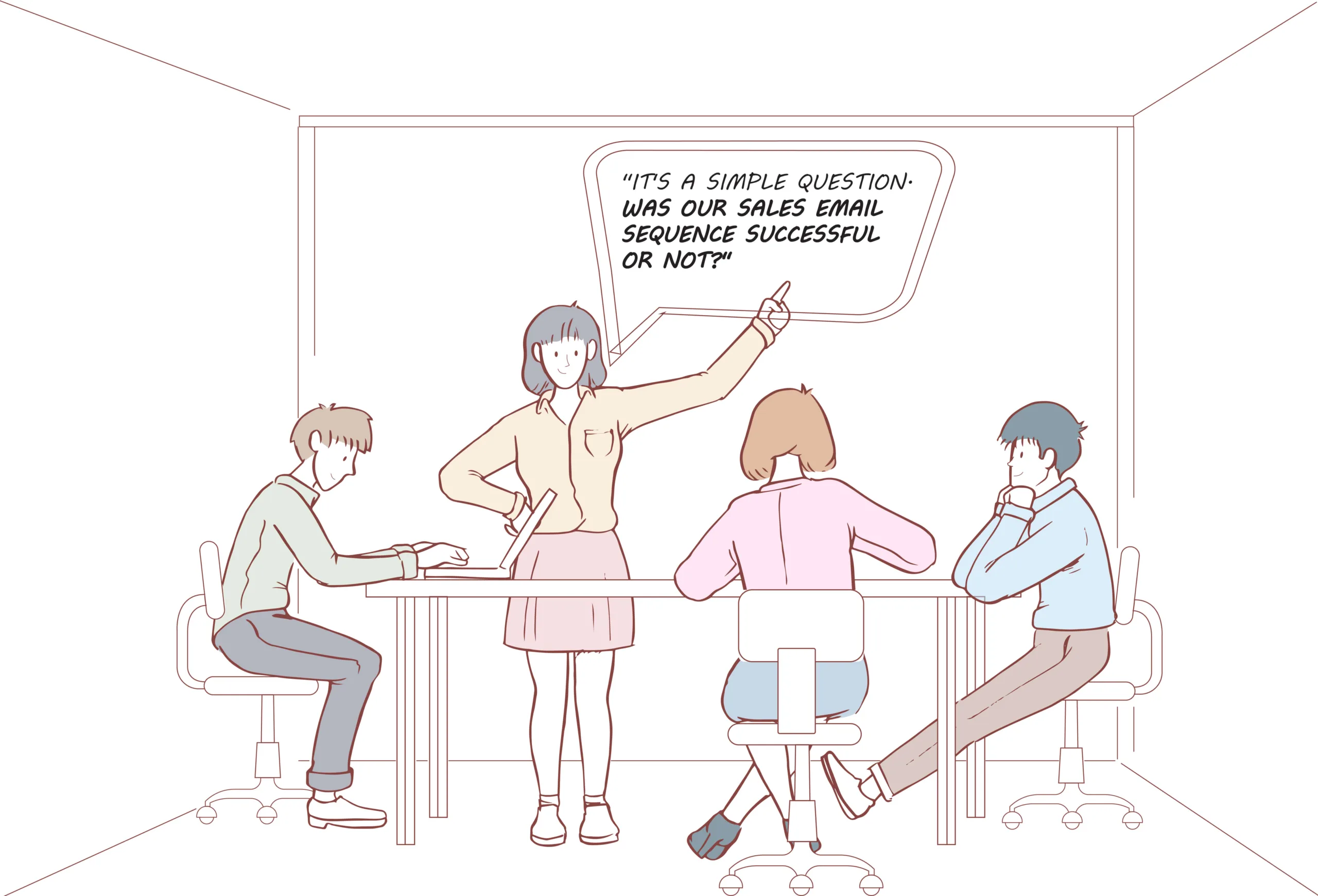
1. Sending Out Overly Generic Messages
Generic, impersonalized emails lack any personalization and fail to address the recipient’s unique characteristics, interests, or needs will rarely drive interest or even catch attention. These emails are not tailored to the specific recipient but follow a one-size-fits-all approach. By not personalizing the content and messaging, businesses miss the opportunity to establish a meaningful connection with the prospect or demonstrate any understanding of their priorities or challenges.
Such emails often come across as spammy or irrelevant, leading to low engagement and poor response rates. Overall, sending generic, impersonalized emails undermines the effectiveness of email marketing campaigns by failing to capture the attention and interest of the recipient, ultimately hindering the desired outcome of driving conversions or sales.
Impact on Engagement and Response Rates
Low Open Rates: Your prospects are less likely to open emails that appear generic or impersonal. When emails lack relevance or fail to address the recipient’s specific needs or interests, they often get overlooked or deleted without being opened, resulting in low open rates for the email campaign.
Lower Click-Through Rates: Even if the recipients see such generic emails, they are quite unlikely to click on any links or calls-to-action contained within the email. Without personalized content that resonates with the recipient, they have little incentive to take further action, leading to decreased click-through rates.
Poor Response Rates: Generic emails typically fail to elicit a response from recipients. When emails lack personalization and fail to connect with the recipient, they are less likely to prompt any form of engagement, such as replying to the email or expressing interest in the offer or product being presented.
Higher Unsubscribe Rates: Your audience may become frustrated or annoyed by generic emails that do not align with their interests or preferences. This can lead to higher unsubscribe rates as recipients opt out of future communications, resulting in a loss of potential opportunity to re-engage.
2. Lack of a Clear Value Proposition
Failing to communicate the value of the product or service clearly occurs when sales emails fail to effectively communicate the unique benefits and value of the product or service to the recipient. Instead of clearly articulating how the product or service can solve the recipient’s problems or meet their needs, the email may focus too much on features or technical details without emphasizing the broader benefits.
As a result, recipients may struggle to understand why they should be interested in the offering or how it can address their specific pain points. Without a clear value proposition, sales emails are less likely to resonate with recipients and compel them to take action, leading to lower engagement and response rates.
Addressing Customer Pain Points Is Key
Understanding Customer Needs: Businesses clearly understand their customers’ challenges, priorities, and goals by identifying and addressing customer pain points. This understanding allows businesses to tailor their offerings and messaging to meet customer needs better, increasing the likelihood of customer satisfaction and loyalty.
Building Trust and Credibility: When businesses acknowledge and empathize with customer pain points, they foster customer trust and credibility. By offering relevant solutions to address these pain points, businesses are valuable partners in solving customer problems, strengthening customer relationships, and enhancing brand reputation.
Differentiation and Competitive Advantage: Addressing customer pain points through innovative solutions helps businesses differentiate themselves from competitors. By offering unique value propositions that directly address customer needs, companies can stand out in the market and attract customers seeking solutions to their specific challenges.
Driving Sales and Revenue: Businesses can drive sales and revenue growth by effectively addressing customer pain points and offering solutions. Customers are more likely to purchase products or services that directly address their pain points and provide tangible benefits. Businesses can increase conversion rates and drive business success by demonstrating how their offerings can solve customer problems and deliver value.
Here’s an example of an email that’s unlikely to draw attention.
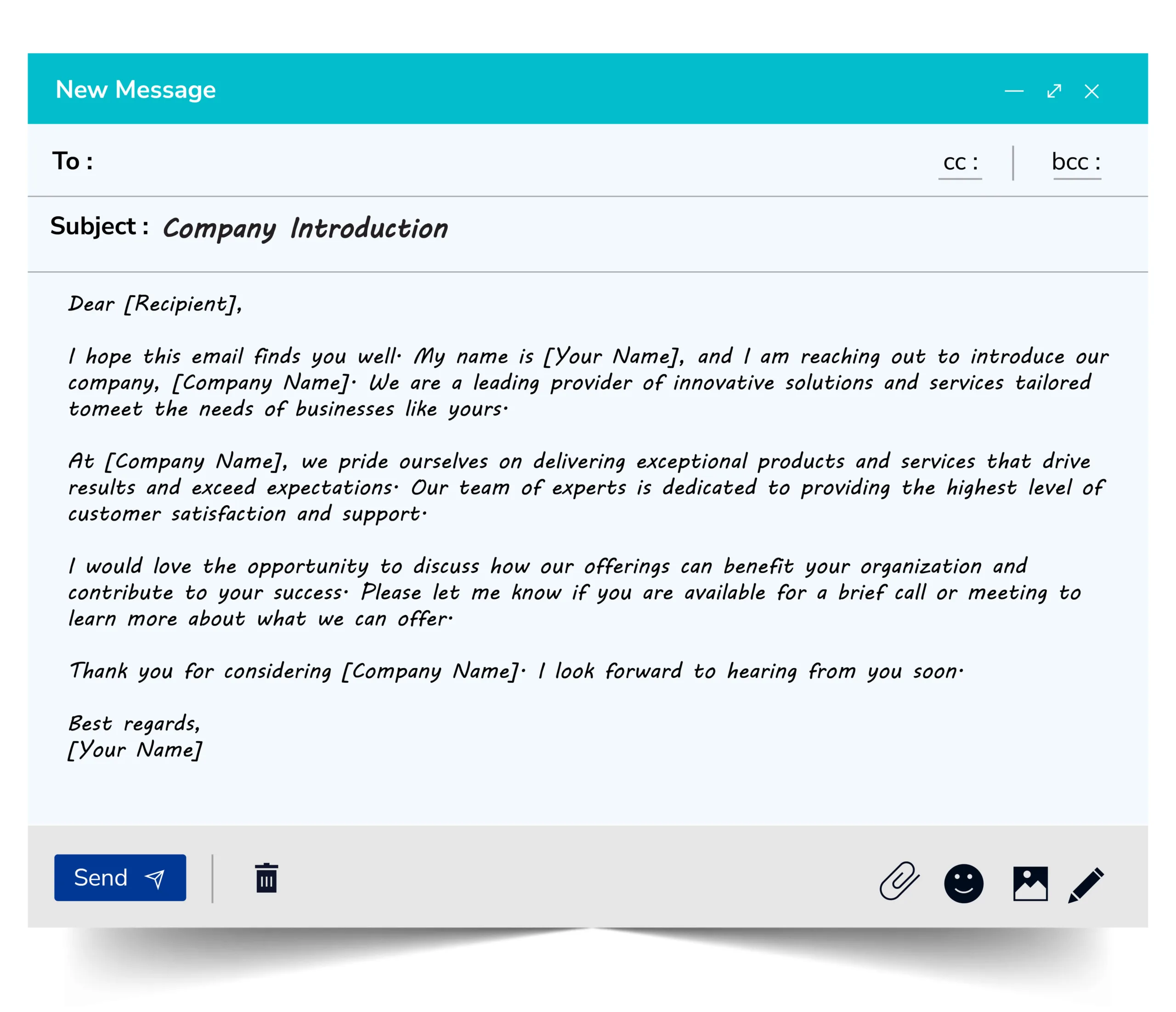
The opening paragraph provides basic information about the sender’s name and company but lacks a clear value proposition. It mentions that the company offers “innovative solutions and services,” but it doesn’t specify the solutions or how they can benefit the recipient’s business. Without a clear value proposition, the recipient may not see the relevance of the email to their needs or interests.
The closing paragraph seeks to discuss how the company’s offerings can benefit the recipient’s organization. Still, it doesn’t provide any compelling reasons why the recipient should be interested in scheduling a call or meeting.
SalesIntel’s go to market teams see over 40% click through rates. Here’s an example of an email that shows relevance, timeliness and personalization.
20% jump in sales velocity for {company.name}
Hi {first name},
I really enjoyed your recent podcast with {company name}’s CRO.
What you said about sales velocity is 100% true today for most mid-sized SaaS companies. But SalesIntel’s customers overcome these challenges. In fact our customers have seen over 20% MoM growth by being able to identify and focus on the right ICP through the funnel.
I can run some tests for {company name} to show how we can address the challenges you were discussing.
Can we schedule 15 mins next Wed, Thu or Fri?
Best,
James
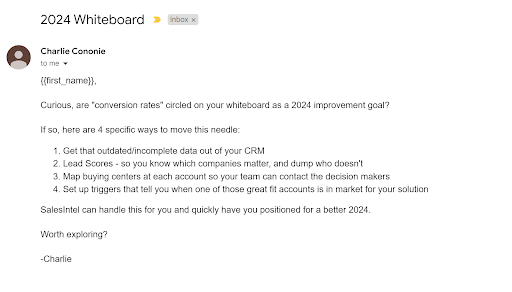
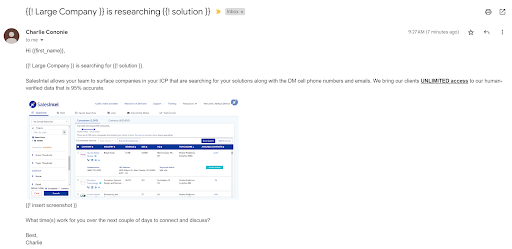
3. Sending Long, Convoluted Emails
When sales emails are overly long and complex, containing abundant information that may overwhelm the recipient, you will likely see less success. Rather than presenting key points concisely and clearly, these emails may delve into unnecessary details, technical jargon, or complex explanations that make it difficult for the recipient to grasp the main message.
As a result, recipients may lose interest or become confused, leading to lower engagement and response rates. Excessive length and complexity in emails can also detract from the overall effectiveness of the communication, making it less likely that the recipient will take the desired action or respond positively to the email.
Crafting concise and impactful sales emails
Crafting concise and impactful sales emails involves several vital strategies:
Clear and Focused Messaging: Keep the content focused on one main idea or objective per email. Avoid unnecessary details or tangents that can clutter the message and confuse the recipient.
Use of Bullet Points or Lists: Use bullet points or lists to break down information into digestible chunks. This makes the email easier to scan and helps highlight key points or benefits.
Personalization: Tailor the email to the recipient’s needs, interests, or pain points. Use merge tags to insert the recipient’s name and reference relevant information to demonstrate understanding and relevance.
Compelling Subject Line: Craft a subject line that grabs attention and entices the recipient to open the email. Keep it concise, clear, and relevant to the content of the email.
Strong Call-to-Action (CTA): Clearly state the desired action you want the recipient to take and make it easy for them to do so. Use persuasive language and provide clear instructions for responding or engaging further.
Proofreading and Editing: Review the email carefully to eliminate any unnecessary words or phrases. Ensure clarity, coherence, and correctness in grammar, spelling, and punctuation.
Mobile Optimization: Consider the readability and formatting of the email on mobile devices. Keep sentences and paragraphs short, use a legible font size, and avoid excessive scrolling.
Here’s one such example from SalesIntel’s email sequencing.
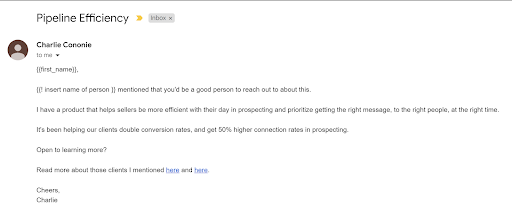
4. Using Pushy or Aggressive Language
Using pushy or aggressive language in sales emails can turn off prospects and negatively impact the effectiveness of the communication. This pitfall occurs when emails employ excessive urgency, exaggerated claims, or forceful demands to pressure recipients into taking immediate action.
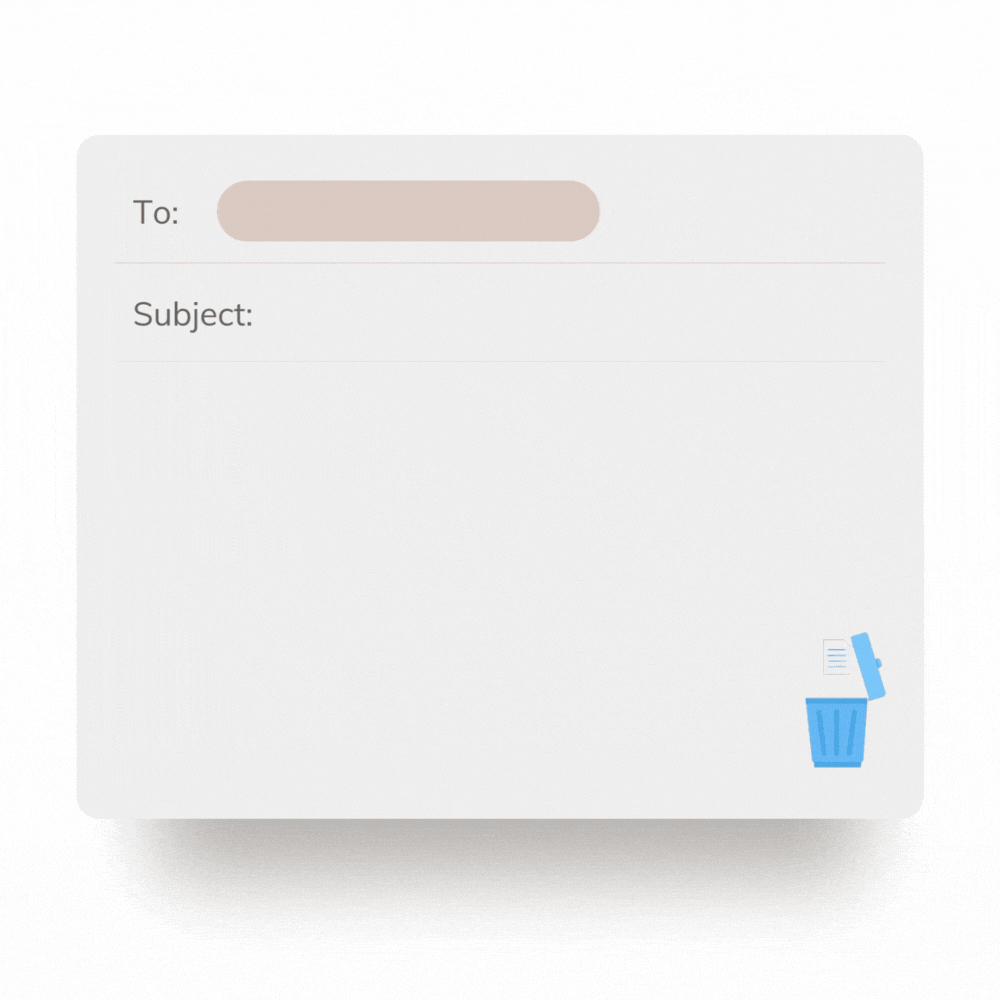
Instead of fostering trust and rapport, such language can come across as insincere, manipulative, or disrespectful, leading to resistance or aversion from the recipient. Pushy or aggressive language undermines the goal of building positive relationships with prospects and may alienate potential customers rather than nurture them through the sales process.
Maintaining a Respectful and Professional Tone
Builds Trust: A respectful tone demonstrates empathy and consideration for the recipient’s perspective, fostering trust and rapport. It conveys professionalism and integrity, which are crucial for establishing credibility and building lasting relationships with prospects.
Enhances Brand Reputation: Professionalism positively affects brand image and reputation. It creates a positive impression of the company and its values, positioning it as a trustworthy and reliable partner in the recipient’s eyes.
Avoids Offending Recipients: Using disrespectful or unprofessional language can alienate recipients and damage relationships. It may lead to negative perceptions of the company and its offerings, resulting in lost opportunities and potential harm to the brand’s reputation.
Use assertive language that encourages action without applying undue pressure. Instead of demanding immediate action, use phrases like “We invite you to explore” or “Discover how our solution can benefit you.”
5. Frequency of Your Sequence Email
The timing of your welcome sequence emails needs careful consideration. Imagine going on a great date and receiving a sweet text the next day expressing interest in meeting again. But what if that’s followed by a barrage of messages asking why you’re not responding quickly enough? It quickly goes from charming to overwhelming, possibly even off-putting.
Similarly, bombarding your email list with too many messages right from the start can make you seem desperate or overly eager. On the other hand, if you’re too infrequent with your emails, your audience might lose interest and move on.
Optimize Your Email Marketing Strategy
Optimizing your email marketing strategy is essential for driving success in today’s dynamic B2B landscape. With the evolution of data and technology, marketers can access a wealth of B2B data beyond basic contact information. This rich data landscape, combined with advanced sales intelligence, revolutionizes how sales sequencing is approached.
Intent data is pivotal in identifying prospects’ readiness to engage with your email content. By leveraging intent data, marketers can gauge prospects’ level of interest and intent, allowing them to tailor their email sequencing accordingly. For instance, prospects showing high intent signals may be more receptive to bottom-of-the-funnel emails focusing on product demos or pricing information. In contrast, those displaying early-stage intent signals may benefit from educational content or thought leadership pieces.
With intent data guiding the way, marketers can strategically map out their email sequencing to align with the prospect’s buying journey. By delivering the right message at the right time based on intent signals, marketers can increase engagement, nurture leads more effectively, and drive conversions.
In today’s competitive landscape, harnessing the power of intent data alongside advanced B2B data solutions like SalesIntel is essential for maximizing the effectiveness of your email marketing efforts. Embrace the insights from intent data to tailor your email sequencing and unlock more tremendous success in your B2B sales journey.
Summing it Up
Finding the right balance between volume and frequency really depends on your industry and your audience. Testing different frequencies is critical to determining what works best for you. A safe starting point could be sending one weekly email for your welcome sequence. If your audience is more responsive, you might opt for a slightly more frequent schedule, perhaps every 3–5 days.
Remember to monitor your open rates to ensure your audience remains engaged without feeling overwhelmed.




